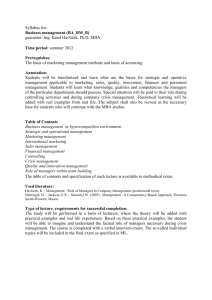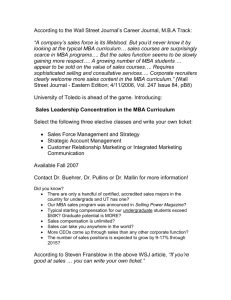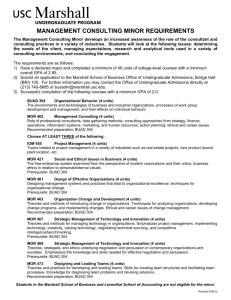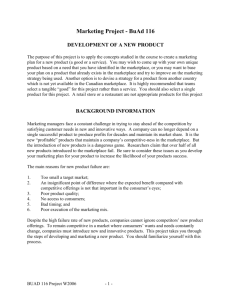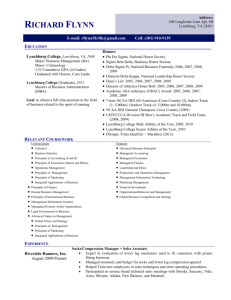Environmental Protection (Chapter 30)
advertisement
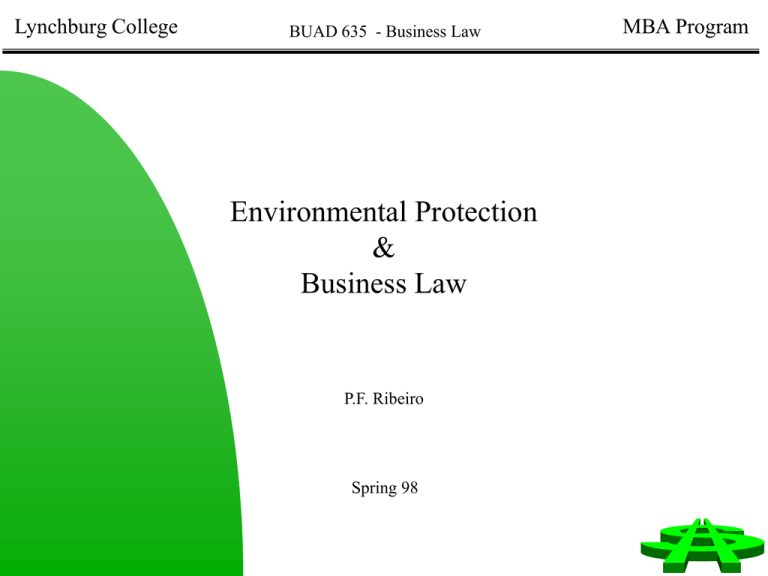
Lynchburg College BUAD 635 - Business Law Environmental Protection & Business Law P.F. Ribeiro Spring 98 MBA Program Lynchburg College BUAD 635 - Business Law MBA Program The Big Picture - The Case for a Holistic Approach To Technological Design The case for a holistic approach to design (planning and operation) rests primarily on the fact that the technological tools and products produced by design and fabrication enter everyday experience as unities. This being the case, design itself should be holistic. Indeed, people’s lives are affected not by technological objects per se, but by how these objects function in all aspects of reality. A car not only conforms to the laws of physics and chemistry, but is also an object of proud ownership, has a value relative to that of alternate purchases, and is a focus of trust, because the buyer believes that if it is used correctly, it will not be harmful. If an object is to function well in all of its aspects, they must be taken into account in its design. And that is what holistic design seeks to do. (Responsible Technology) Lynchburg College BUAD 635 - Business Law Outline 1. Introduction 2. TheNEPA and Policies 3. Air Pollution 4. The Business Side 5. Cases 6. Conclusions MBA Program Lynchburg College BUAD 635 - Business Law MBA Program 1. Introduction The Dialectic Nature of Environmental Protection •Inevitable Population Growth Leads to Depletion of Earth’s Resources and Generates Pollution •Total Pollution Protection Is Impractical •Advanced (Nuclear) Energy Generation: Catastrophic Failure Risk The Inconsistent Approach: Public versus Private Requirements •Electric Fields From Power Lines versus Hair Dryers Facts and Fiction •Global Warming Controversy - A Scientific Speculation •Global Weather Conditions (Solar Flares, El-Nino) Lynchburg College BUAD 635 - Business Law MBA Program The Power System Value Business Chain Power System Value Chain Environmental Maintainability Availability Safety Efficiency Reliability Performance Price Power Quality Lynchburg College BUAD 635 - Business Law MBA Program 2. The National Environmental Policy Act (NEPA) and Policies NEPA •Enacted in 1969, Effective 1970 •Mandates that the federal government consider the adverse impact of federal actions on the environment. EPA •Created by congress in 1970 •Coordinate the implementation and enforcement of the federal environment protection laws Policies • EIS, NAAQS, RACT, BACT, MACT, FWPCA, BPCT, MPRSA, OPA, RCRA, CERCLA, NRC, Lynchburg College BUAD 635 - Business Law MBA Program • NAAQS - National Ambient Air Pollution Standards • RACT - Reasonably Available Control Technology • BACT - Best Available Control Technology • MACT - Maximum Achievable Control Technology • FWPCA - Federal Water Pollution Control ACT of 1948 • BPCT - Best Practical Control Technology • SDWA - Safe Drinking Water Act, 1972 • OPA - Oil Pollution Act, 1990 • RCRA - Resource Conservation and Recovery Act • CERCLA - Comprehensive Environmental Response, Compensation, and Liability Act • NRC - Nuclear Regulatory Commission (Nuclear Waste Policy Act of 1982) Lynchburg College BUAD 635 - Business Law 3. Air Pollution •Clean Act Air •Standards •Stationary Sources •Mobile Sources •Toxic Air Pollutants MBA Program Lynchburg College BUAD 635 - Business Law 4. The Business Side Smog Swapping •Business versus Environmentalism •Market-basis Trading Scheme MBA Program Lynchburg College BUAD 635 - Business Law MBA Program 5. Cases Case 1 - Natural Resources Defense Council, INC. V. Environmental Protection Agency, District of Columbia Circuit Facts •Vinyl Gaseous - Synthetic chemical used in the manufacture of plastic •Strong carcinogen •EPA rule establishes emission standards for vinyl chloride under section 112 of the Clean Air Act. •The standard provides ample margin of safety to protect the public health. •The National Resources Defense Council sued the EPA Issue Must EPA set a zero level of emissions of the toxic pollutant vinyl chloride? Decision No. Reason. The court stated that zero level of emissions is unreasonable Lynchburg College BUAD 635 - Business Law MBA Program Case 2 - TVA v. Hill, Secretary of the Interior United States Supreme Court FACTS •TVA operates a series of dams, water and electric power plants. •In 1967 TVA began construction of the Tellico Dam on the Little Tennessee River. •In 1973, a University of Tennessee ichthyologist found a previously unknown species of perch called Percina Tansai -- or “snail darter”--in the Littel Tennessee River. The snail darter was not found anywhere else in the world. The Tellico Dam would destroy the snail darte’s food and oxygen supplies, causing its extinction. •Also in 1973, Congress enacted the Endangered Species Act (Act) •The Secretary of the Interior declared the snail darter an endangered species and the area that would be affected by the Dam its critical habitat. •In 1976, a conservation group field an action seeking to enjoin the TVA from closing the gates of the dam.on the grounds that would violate Section 7 of the Act. •The District Court held in favor of TVA. •The court of appeals reversed the decision. TVA appealed to the US Supreme Court. ISSUES •Would the TVA be in violation of the Endangered Species Act if it operated the dam? DICISION Yes. Affirmed Lynchburg College BUAD 635 - Business Law MBA Program Developing Cases Regional Case - AEP Line ROANOKE, Va. - American Electric Power has reaffirmed its commitment to build a major transmission line in Virginia and West Virginia. "The need for the proposed line, which has been confirmed by the Commission's independent consultant Stone & Webster, by the hearing examiner and by the Commission itself in the Interim Order, has received national attention in the wake of the widespread blackouts experienced in the Western United States during July and August of 1996," AEP's filing said. A recent report by the U.S. Department of Energy to the President on the Western Blackouts in July identified delay in the Wyoming-Cloverdale project as being one of two specific areas of significant concern regarding potential problems in the reliability of the nation's electricity supply. AEP's filing today stems from the release last June of the U.S. Forest Service's Draft Environmental Impact Statement (DEIS) on the proposed line. "Notwithstanding the fact that the DEIS...preliminarily identifies a 'no-action alternative' AEP recognizes that it must, in one way or another, do all it reasonably can to address a demonstrated, substantial and urgent need for a significant reinforcement to the transmission facilities serving (southern West Virginia and Virginia)," AEP said in its filing. Lynchburg College BUAD 635 - Business Law MBA Program AEP said it had reconsidered alternatives to the transmission line. "The company also has reviewed all realistic alternatives to the proposed line...and has concluded that the proposed Wyoming-Cloverdale project remains far and away the best, and in fact the only reasonable, overall solution to the compelling need for additional electric transmission capacity, AEP's original preferred corridor, a 115-mile route from Wyoming Station near Oceana, West Virginia, to Cloverdale Station near Roanoke, Virginia, was selected by a team of experts from Virginia Tech and West Virginia University. "The company now estimates that the project cannot be completed, even under a best-case scenario, before December 2002," AEP said. AEP plans to use existing and new operating procedures to limit the possibility of widespread blackouts that could occur during certain conditions between 1998 and 2002. Because the risk of conditions occurring that could lead to uncontrolled blackouts will remain significant, even after implementation of these interim measures, AEP will develop a load shedding program. This program will be designed to implement controlled partial blackouts in order to mitigate growing susceptibility to uncontrolled widespread system blackouts," the company said in its filing. Lynchburg College BUAD 635 - Business Law MBA Program Developing Cases International - The Burning The Amazon Rain Forest An analysis of satellite data by the Environmental Defense Fund (EDF) indicates that burning of rainforest land in the Brazilian Amazon increased 28% between 1996 and 1997. The analysis of data from National Oceanic and Atmospheric Administration (NOAA) satellite images examined fires from August and September, the burning season, for each year. A total of 19,115 fires are reported from the NOAA-12 satellite images in the sample in 1996, while 24,549 fires appear in the 1997 data over the period, an increase of 28%. The average number of fires per day increased from 466 to 599. The actual increase for the year may be even greater, since 1997 is drier than 1996 and burning continues. "Increased burning strongly suggests that deforestation rates continue to rise," said EDF senior scientist Stephan Schwartzman. "Along with new data from the region showing that what appears on the satellite pictures is only half the story, this is cause for serious concern. " Lynchburg College BUAD 635 - Business Law MBA Program 6. Conclusions Environmenatl Protection Very Complex Problem (Contradictory Interests) Local versus Global Conditions Gobal Picture: All Aspects of Reality Need to Be Considered Need For Self-Sustainable Economy and Environmental Conditions Shared Responsibiltiy: Citizen and Government
